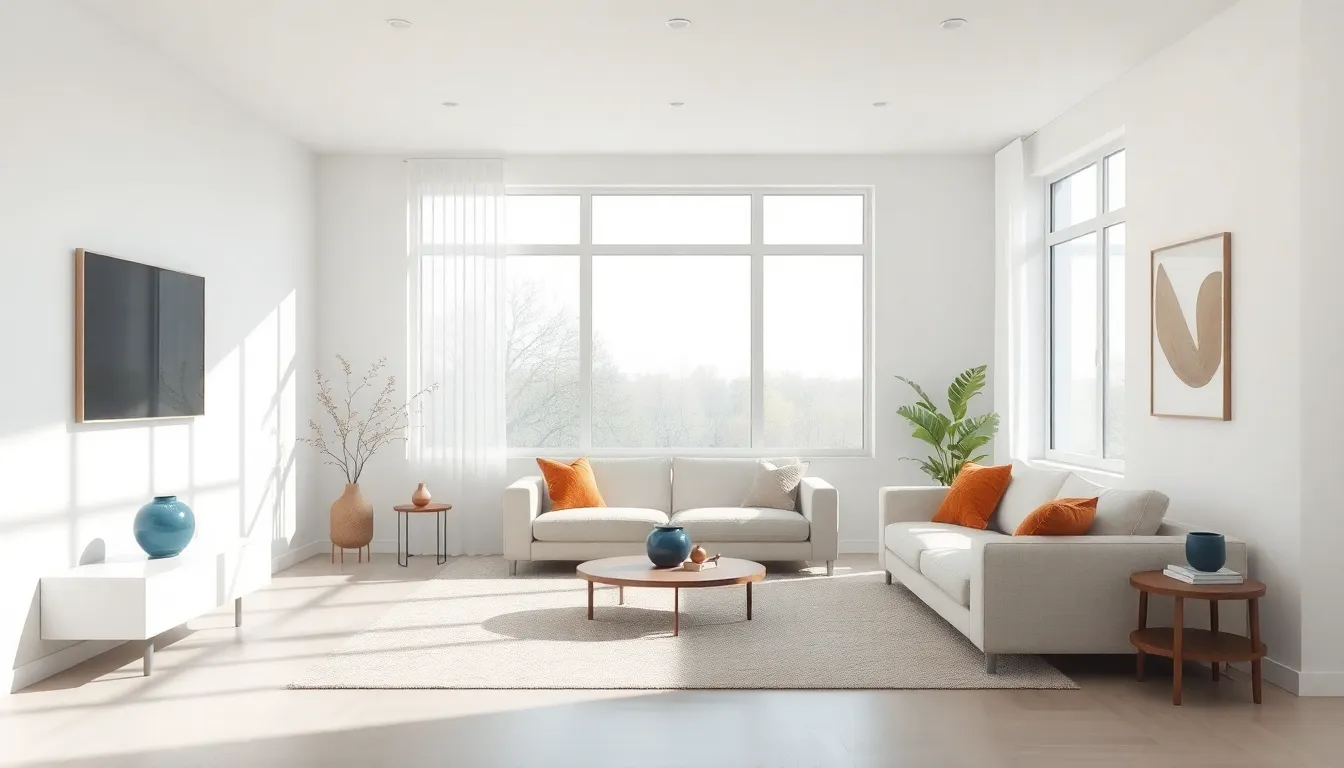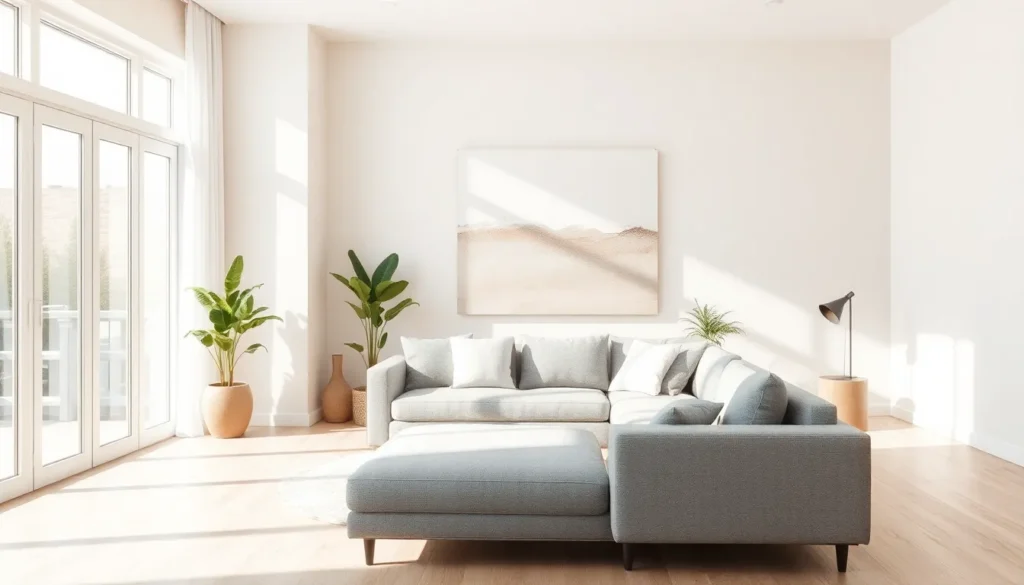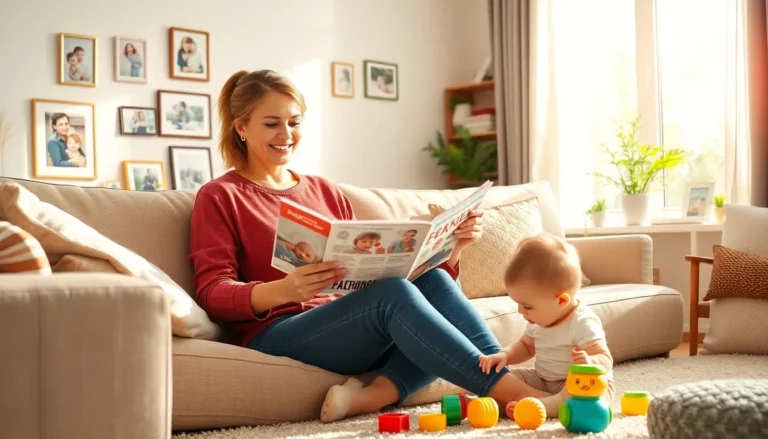Table of Contents
ToggleIn a world overflowing with stuff, embracing minimalist living room decor can feel like a breath of fresh air—or a deep sigh of relief. Imagine stepping into a space where every item serves a purpose and clutter is just a distant memory. It’s not just about less; it’s about more—more peace, more clarity, and more room for activities that matter.
Understanding Minimalist Living Room Design
Minimalist living room design fosters simplicity and tranquility. This approach emphasizes functionality and aesthetics, contributing to a more harmonious space.
Key Principles of Minimalism
Simplicity is at the core of minimalist design. Excessive decor or furniture distracts from the space’s overall purpose. Functionality takes precedence, ensuring every item serves a specific role. Neutral color palettes help create a calm atmosphere. Textures contribute depth without overwhelming the senses. Natural light plays a crucial role, enhancing the openness of the room. Open spaces promote a sense of freedom and unencumbered movement.
Benefits of Minimalist Decor
Reduced clutter leads to improved focus and relaxation. Minimalist decor encourages mindful living by promoting intentional choices. Easy maintenance saves time, allowing for more meaningful activities. A streamlined aesthetic can enhance the perceived size of the room. Minimalist decor reduces stress by creating an orderly environment. Enhanced creativity springs from a distraction-free space. Cost-effectiveness often arises from investing in fewer, higher-quality items.
Color Schemes for Minimalist Living Rooms

Color schemes serve as an essential element in minimalist living room decor. They create a tranquil atmosphere while enhancing the overall aesthetic.
Neutral Color Palettes
Neutral color palettes dominate minimalist living rooms. Shades like whites, grays, and beiges form a serene backdrop, promoting a sense of calm. Using these tones allows natural light to play a greater role in enhancing space. Rooms appear larger and more inviting when filled with soft, subdued hues. Pairing different neutrals can add warmth without overwhelming the senses. Using a single dominant neutral color with slight variations keeps the room visually interesting and cohesive. Each piece, from furniture to accessories, reinforces the minimalist approach while maintaining simplicity.
Accent Colors for Depth
Accent colors inject personality into minimalist spaces without cluttering the design. Deep blues, warm terracottas, or muted greens work well as focal points. Selecting one or two accent colors creates visual interest and depth while keeping the minimalist essence intact. Accessories like throw pillows or art pieces provide opportunities for these vibrant accents. When strategically placed, these colors draw the eye but remain balanced. The use of accent colors highlights key design elements, emphasizing the simplicity of the overall decor. Thoughtful application of accents contributes to a harmonious environment that remains uncluttered.
Furniture Selection for Minimalist Spaces
Furniture selection plays a critical role in establishing a minimalist living room. Choosing carefully can emphasize simplicity while enhancing functionality.
Choosing Multi-functional Furniture
Selecting multi-functional furniture immediately maximizes efficiency in minimalist spaces. Sofas that convert into beds, coffee tables with storage, and ottomans that serve as seating accommodate varied needs without clutter. Pieces like a sleek dining table that doubles as a workspace maintain versatility while prioritizing practicality. Investing in furniture that serves multiple purposes streamlines the environment and promotes order.
Importance of Scale and Proportion
Understanding scale and proportion significantly influences the minimalist aesthetic. Furniture needs to complement the size of the living room; oversized items can overwhelm smaller spaces. Coordinating proportions ensures a sense of balance, promoting a serene atmosphere. When selecting pieces, prioritize those that enhance openness, allowing for movement. Balance low-profile furniture with taller accents to create visual interest while maintaining simplicity.
Decor Elements That Enhance Minimalism
Minimalist decor benefits from carefully selected elements that enhance clarity and tranquility. This approach provides a serene and uncluttered aesthetic.
Art and Wall Decor Ideas
Art serves as a focal point, adding character without overwhelming the space. Consider choosing abstract pieces in muted colors; they create visual interest while maintaining a calming atmosphere. Using oversized canvases complements the minimalist look, drawing the eye without crowding the walls. Incorporate frames that match the decor’s color palette; uniformity adds to harmony. Wall-mounted shelving provides display options for select art pieces while keeping the floor space clear. This strategic placement enhances simplicity and functional beauty.
Textiles and Soft Furnishings
Textiles contribute warmth and texture, essential features in minimalist living rooms. Opt for neutral-colored cushions and throws; these items invite comfort without detracting from simplicity. Choose lightweight fabrics like linen or cotton that maintain an airy feel; they offer elegance and ease. Area rugs can define spaces within larger rooms, adding a layer of softness underfoot. Prioritize quality over quantity; fewer, high-quality textiles ensure a cohesive and inviting environment. Minimalist approach to patterns, like subtle textures or monochromatic designs, adds depth while adhering to decor principles.
Tips for Achieving a Minimalist Look
Creating a minimalist look in a living room centers on simplicity and purpose. Each element should contribute meaningfully to the overall aesthetic.
Decluttering Strategies
Focus on removing excess items to establish a clean and serene environment. Start with surfaces such as coffee tables and shelves; keep only essential items. Utilize storage solutions like baskets or boxes to organize smaller items and maintain order. Implement the one-in-one-out rule: for every new item brought in, an old one should leave. Regularly assess items’ functionality and emotional value to decide what to keep. Keeping intentionally chosen decor pieces enhances tranquility and reduces distractions.
Creating a Focal Point
Select a single, standout piece to draw attention, such as an oversized art piece or a striking piece of furniture. This element becomes the room’s visual anchor, guiding the eye and adding interest. Use neutral tones throughout the space to allow the focal point to stand out effectively. Position lighting strategically to highlight this chosen item, further enhancing its impact. Surrounding decor should complement the focal piece without overwhelming it, fostering a harmonious balance in the space.
Embracing minimalist living room decor can transform any space into a serene retreat. By focusing on simplicity and functionality, individuals can create an environment that promotes relaxation and clarity. Thoughtfully selected furniture and decor elements not only enhance aesthetics but also serve practical purposes, making everyday living more enjoyable.
Incorporating neutral color palettes and strategic lighting further elevates the ambiance, ensuring the space feels open and inviting. This approach not only reduces clutter but also fosters mindfulness and creativity. Ultimately, minimalist decor encourages a lifestyle centered around quality over quantity, allowing for a more meaningful and fulfilling living experience.







